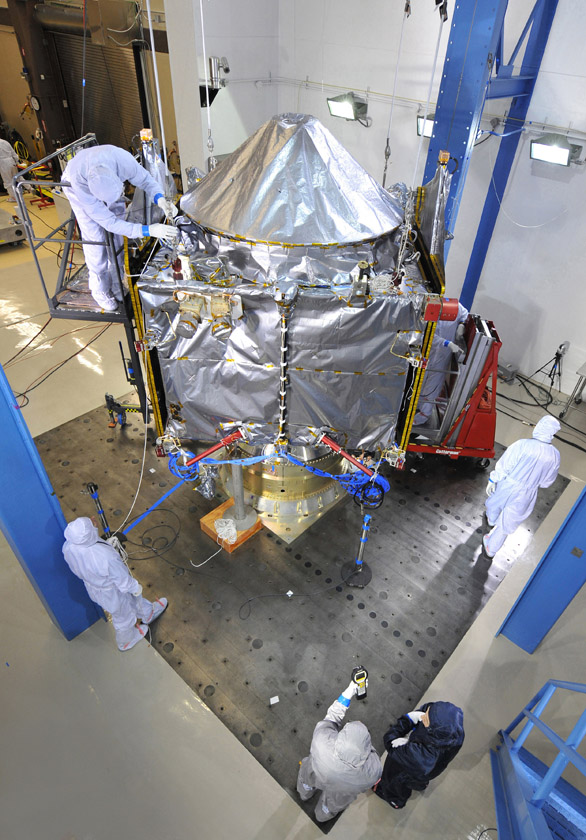
NASA has announced that a recent rock sample taken from Mars indicates the planet could have once supported living micro-organisms — just as the Laboratory for Atmospheric and Space Physics at the University of Colorado announced it has crossed another milestone in building NASA’s Mars Atmosphere and Volatile Evolution Mission (MAVEN).
The rock sample was collected by NASA’s Curiosity rover, which is charged with finding any evidence Mars could have supported life. Scientists found sulfur, nitrogen, hydrogen, phosphorus and carbon — elements that sustain life — in powder from the rock.
“A fundamental question for this mission is whether Mars could have supported a habitable environment,” Michael Meyer, lead scientist for NASA’s Mars Exploration Program, told Science Daily. “From what we know now, the answer is yes.”
The evidence was sourced from sedimentary rock, composed of mudstone and clay materials, found in an ancient stream bed near the rim of the Gale Crater. The presence of clay, which forms in water with neutral pH, is a good indicator that Mars once had water.
“We have found a habitable environment that is so benign and supportive of life that probably if this was around and you had been on the planet, you would have been able to drink it,” John P. Grotzinger, principal investigator for the NASA mission, told The New York Times.
The Curiosity rover’s discovery of the rock, which leads scientists to believe there was once water on Mars, illustrates the purpose of the upcoming MAVEN mission.
The Mars Atmosphere and Volatile Evolution mission is the first devoted to increasing our knowledge of the Martian upper atmosphere, according to the MAVEN website.
Among the questions scientists hope to answer through this mission is, where did the Martian atmosphere and the water go?
Six instruments responsible for characterizing the solar wind ionosphere of Mars have been successfully installed onto MAVEN, including one designed to study solar wind in teraction with Mars and how that might have changed the upper atmosphere to lead to the loss of atmospheric gas.The Solar Wind Electron Analyzer was the final instrument to be delivered and integrated onto MAVEN.
The MAVEN, which is being assembled at Lockheed Martin in Littleton, is scheduled to launch in the fall.
— Erica Lindberg
EPA REPORTS FUEL ECONOMY GAINS IN 2012
A recent report on fuel economy in the United States, released by the Environmental Protection Agency (EPA), suggests that people in the U.S. are making progress toward driving more fuel-efficient cars.
Fuel economy measures how much fuel is used compared to the distance traveled in a vehicle. In 2012 there was an increase of 1.4 miles per gallon for trucks and cars. The report also estimates that, between 2007 and 2012, fuel economies increased by 16 percent, while carbon dioxide emissions have decreased by 13 percent.
“Today’s report shows that we are making strides toward saving families money at the pump, reducing greenhouse gas emissions and cleaning up the air we breathe,” says Gina McCarthy, assistant administrator for the EPA’s Office of Air and Radiation.
Fuel economy is expected to continue to grow under the Obama administration’s new national clean car program standards.
The National Clean Vehicle program, established in 2010 by the EPA and the Department of Transportation, set new standards regarding greenhouse gas and fuel economy of vehicles.
The program’s standards are expected to save American families $1.7 trillion in fuel costs — a projected $8,000 per vehicle — and save 12 billion barrels of oil by 2025.
“The historic steps taken by the Obama administration to improve fuel economy and reduce our dependence on foreign oil are accelerating this progress, will spur economic growth and will create high-quality domestic jobs in cutting-edge industries across America,” McCarthy says.
Diversity among the cars available in the United States has also helped reduce CO2 emissions, according to the EPA. An increase in hybrid/diesel vehicles, plug-in electric car models and more car models with a fuel economy of 30 mpg or higher has given consumers twice as many environmentally minded choices when it comes to driving a car than they had five years ago.
— Erica Lindberg














